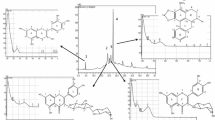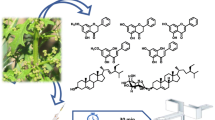Abstract
Various essential oils from plants and fragrance components such as monoterpenes have been discovered to reduce spontaneous movements in mice; thus, it has been made clear that the odor itself has the sedative activity. In the present study, we examined the sedative activity of the odors of fragrance components added to eye drops; l-menthol, d-camphor, phenylethyl alcohol, and geraniol, which are often used as refreshers or preservatives. Each fragrance component was administered by the inhalation route to mice, and the sedative effects were evaluated using an open field test. The results showed that four components administered via inhalation to mice significantly decreased the amount of spontaneous motor activity in a dose-dependent manner, indicating that all four components have a sedative effect. The optimal concentrations at which l-menthol, d-camphor, phenylethyl alcohol, and geraniol showed the highest sedative activity were 4 × 10–2 mg per cage, 4 × 10–4 mg per cage, 4 × 10–2 mg per cage, and both 4 × 10–4 and 4 × 10–2 mg per cage, respectively. The AUC graph of geraniol was represented as a W-shaped curve, suggesting that the sedative action of geraniol was biphasic. The present finding demonstrates a new perspective on a possible pharmacological property of eye drop additives used with no expected pharmacological functions.






Similar content being viewed by others
References
Takemoto H, Ito M, Shiraki T, Yagura T, Honda G (2008) Sedative effects of vapor inhalation of agarwood oil and spikenard extract and identification of their active components. J Nat Med 62:41–46. https://doi.org/10.1007/s11418-007-0177-0
Takemoto H, Yagura T, Ito M (2009) Evaluation of volatile components from spikenard: valerena-4,7(11)-diene is a highly active sedative compound. J Nat Med 63:380–385. https://doi.org/10.1007/s11418-009-0340-x
Ito K, Ito M (2011) Sedative effects of vapor inhalation of the essential oil of Microtoena patchoulii and its related compounds. J Nat Med 65:336–343. https://doi.org/10.1007/s11418-010-0502-x
Tankam JM, Ito M (2014) Sedative, anxiolytic and antidepressant-like effects of inhalation of the essential oil of Ocimum gratissimum L. from Cameroon in mice. J Pharmacogn Phytochem 2:1–9
Fujiwara Y, Ito M (2015) Synergistic effect of fragrant herbs in Japanese scent sachets. Planta Med 81:193–199. https://doi.org/10.1055/s-0034-1396138
Dougnon G, Ito M (2020a) Sedative efrects of the essential oil from the leaves of Lantana camara occurring in the Republic of Benin via inhalation in mice. J Nat Med 74:159–169. https://doi.org/10.1007/s11418-019-01358-9
Pharmaceutical and Medical Device Regulatory Science Society of Japan (ed) (2016) The Japanese Pharmacopoeia 17th edn. Jiho, Inc., Tokyo, pp. 9
Kukreja AK, Dhawan OP, Ahuja PS, Sharma S, Mathur AK (1992) Genetic improvement of mints: on the qualitative traits of essential oil of in-vitro derived clones of Japanese mint (Mentha arvensis var. piperascens Holmes). J Essen Oil Res 4(6):623–629. https://doi.org/10.1080/10412905.1992.9698145
Chen W, Vermaak I, Viljoen A (2013) Camphor—a fumigant during the black death and a coveted fragrant wood in ancient Egypt and Babylon—a review. Molecules 18(5):5434–5454. https://doi.org/10.3390/molecules18055434
McKemy DD, Neuhausser WM, Julius D (2002) Identification of a cold receptor reveals a general role for TRP channels in thermosensation. Nature 416:52–58. https://doi.org/10.1038/nature719
Selescu T, Ciobanu AC, Dobre C, Reid G, Babes A (2013) Camphor activates and sensitizes transient receptor potential melastatin 8 (TRPM8) to cooling and icilin. Chem Senses 38:563–575. https://doi.org/10.1093/chemse/bjt027
Behrendt HJ, Germann T, Gillen C, Hatt H, Jostock R (2004) Characterization of the mouse cold-menthol receptor TRPM8 and vanilloid receptor type-1 VR1 using a fluorometric imaging plate reader (FLIPR) assay. Br J Pharmacol 141:737–745. https://doi.org/10.1038/sj.bjp.0705652
Moleyar V, Narasimham P (1992) Antibacterial activity of essential oil components. Int J Food Microbiol 16(4):337–342. https://doi.org/10.1016/0168-1605(92)90035-2
Nakamura H (1968) Physiological function of phenetyl alcohol. Kagaku to Seibutsu 6(5):267–272
Rao BRR, Kaul PN, Syamasundar KV, Ramesh S (2005) Chemical profiles of primary and secondary essential oils of palmarosa (Cymbopogon martinii (Roxb.) Wats var. motia Burk.). Ind Crops Prod 21:121–127. https://doi.org/10.1016/j.indcrop.2004.02.002
Mahalwal VS, Ali M (2003) Volatile constituents of Cymbopogon nardus (Linn) Rendle. Flavour Fragr J 18:73–76. https://doi.org/10.1002/ffj.1144
Ghannadi A, Bagherinejad MR, Abedi D, Jalali M, Absalan B, Sadeghi N (2012) Antibacterial activity and composition of essential oils from Pelargonium graveolens L’Her and Vitex agnus-castus L. Iran J Microbiol 4:171–176
Baydar H, Baydar N (2005) The effects of harvest date, fermentation duration and Tween 20 treatment on essential oil content and composition of industrial oil rose (Rosa damascena Mill.). Ind Crops Prod 21(2):251–255. https://doi.org/10.1016/j.indcrop.2004.04.004
Tankam JM, Ito M (2013) Inhalation of the essential oil of Piper guineense from sedative and anxiolytic-like effects in mice. Biol Pharm Bull 36(10):1608–1614
Dougnon G, Ito M (2020b) Inhalation administration of the bicyclic ethers 1,8- and 1,4-cineole prevent anxiety and depressive-like behaviours in mice. Molecules 25:1884. https://doi.org/10.3390/molecules25081884
Hossain SJ, Hamamoto K, Aoshima H, Hara Y (2002) Effects of tea components on the response of GABAA receptors expressed in Xenopus Oocytes. J Agric Food Chem 50:3954–3960. https://doi.org/10.1021/jf011607h
Qneibi M, Jaradat N, Emwas N (2019) Effect of geraniol and citronellol essential oils on the biophysical gating properties of AMPA receptors. Appl Sci 9:4693. https://doi.org/10.3390/app9214693
Ueno H, Shimada A, Suemitsu S, Murakami S, Kitamura N, Wani K, Matsumoto Y, Okamoto M, Ishihara T (2019) Anti-depressive-like effect of 2-phenylethanol inhalation in mice. Biomed Pharmacother 111:1499–1506. https://doi.org/10.1016/j.biopha.2018.10.073
Medeiros KAAL, Santos JR, Melo TCS, de Souza MF, de Santos GL, de Gois AM, Cintra RR, Lins LCRF, Ribeiro AM, Marchioro M (2018) Depressant effect of geraniol on the central nervous system of rats: behavior and ECoG power spectra. Biomed J 41:298–305. https://doi.org/10.1016/j.bj.2018.08.008
Hall AC, Turcottea CM, Bettsa BA, Yeunga W, Agyemana AS, Al B (2004) Modulation of human GABAA and glycine receptor currents by menthol and related monoterpenoids. Eur J Pharmacol 506:9–16. https://doi.org/10.1016/j.ejphar.2004.10.026
Kagawa D, Jokura H, Ochiai R, Tokimitsu I, Tsubone H (2003) The sedative effects and mechanism of action of cedrol inhalation with behavioral pharmacological evaluation. Planta Med 69:637–641. https://doi.org/10.1055/s-2003-41114
Ito K, Ito M (2013) The sedative effect of inhaled terpinolene in mice and its structure–activity relationships. J Nat Med 67:833–837. https://doi.org/10.1007/s11418-012-0732-1
Ito K, Akahoshi Y, Ito M, Kaneko S (2016) Sedative effects of inhaled essential oil components of traditional fragrance Pogostemon cablin leaves and their structure–activity relationships. J Trad Complemen Med 6:140–145. https://doi.org/10.1016/j.jtcme.2015.01.004
Takemoto H, Omameuda Y, Ito M, Fukuda T, Kaneko S, Akaike A, Kobayashi Y (2014) Inhalation administration of valerena-4,7(11)-diene from Nardostachys chinensis roots ameliorates restraint stress-induced changes in murine behavior and stress-related factors. Biol Pharm Bull 37(6):1050–1055
Miyoshi T, Ito M, Kitayama T, Isomori S, Yamashita F (2013) Sedative effects of inhaled benzylacetone and structural features contributing to its activity. Biol Pharm Bull 36(9):1474–1481
Acknowledgements
The authors would like to thank Santen Pharmaceutical Co., Ltd. for financial support.
Author information
Authors and Affiliations
Corresponding author
Additional information
Publisher's Note
Springer Nature remains neutral with regard to jurisdictional claims in published maps and institutional affiliations.
Rights and permissions
About this article
Cite this article
Oshima, T., Ito, M. Sedative effects of l-menthol, d-camphor, phenylethyl alcohol, and geraniol. J Nat Med 75, 319–325 (2021). https://doi.org/10.1007/s11418-020-01470-1
Received:
Accepted:
Published:
Issue Date:
DOI: https://doi.org/10.1007/s11418-020-01470-1




